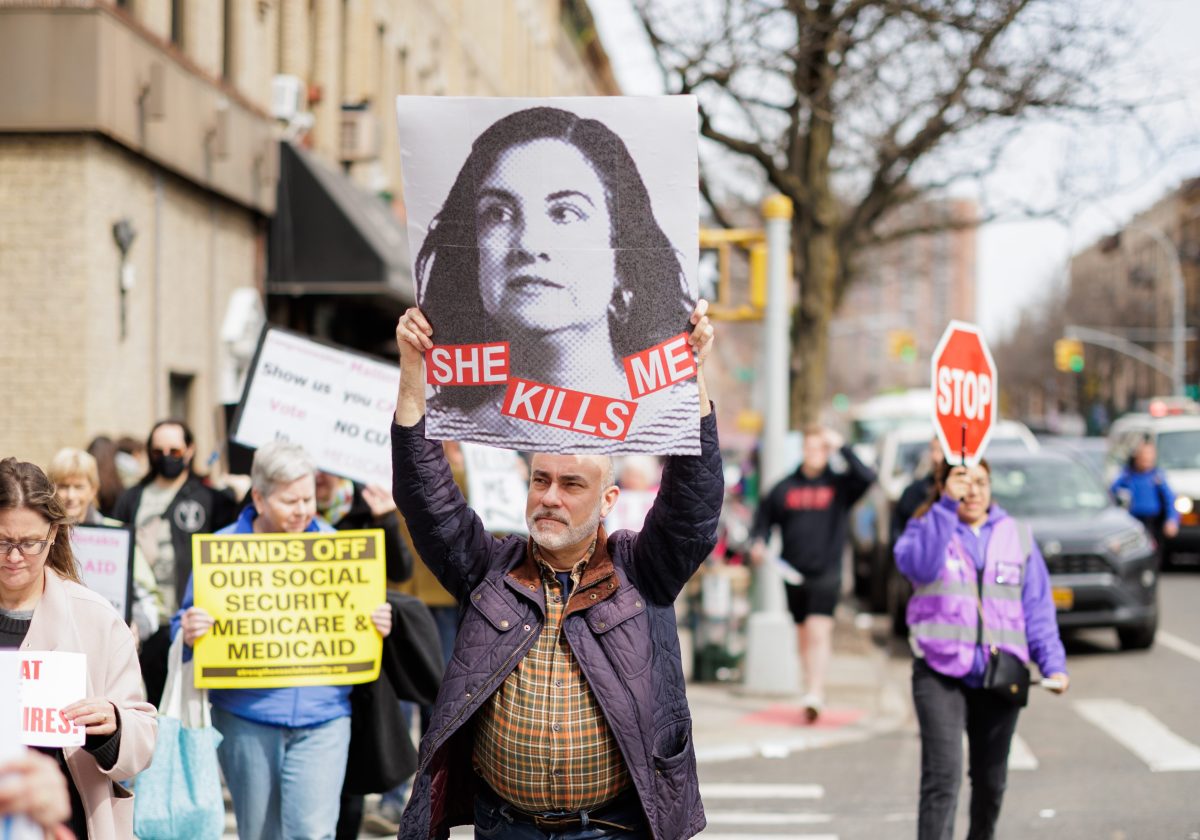Monday’s astounding story that the most senior members of President Donald Trump’s administration planned military strikes on Yemen over an unsecure commercial messaging app, on which they had included national security reporter and editor in chief of The Atlantic Jeffrey Goldberg, has escalated over the past two days.
On Monday, Secretary of Defense Pete Hegseth looked directly at a reporter’s camera and said: “Nobody was texting war plans.” Throughout the day Tuesday, the administration doubled down on this assertion, apparently convinced that Goldberg would not release the information they knew he had. They tried to spin the story by attacking Goldberg, suggesting he had somehow hacked into the conversation, although the app itself tracked that National Security Advisor Michael Waltz had added him.
Various administration figures, including Trump, insisted that the chat contained nothing classified. At a scheduled hearing yesterday before the Senate Intelligence Committee on worldwide threats, during which senators took the opportunity to dig into the Signal scandal, Director of National Intelligence Tulsi Gabbard said: “There was no classified material that was shared in that Signal group.” Director of the Central Intelligence Agency John Ratcliffe agreed: “My communications, to be clear, in the Signal message group were entirely permissible and lawful and did not include classified information.” In the afternoon, Trump told reporters: “The attack was totally successful. It was, I guess, from what I understand, took place during. And it wasn’t classified information. So this was not classified.”
After Gabbard said she would defer to the secretary of defense and the National Security Council about what information should have been classified, Senator Angus King (I-ME) seemed taken aback. “You’re the head of the intelligence community. You’re supposed to know about classifications,” he pointed out. He continued, “So your testimony very clearly today is that nothing was in that set of texts that were classified.... If that’s the case, please release that whole text stream so that the public can have a view of what actually transpired on this discussion. It’s hard for me to believe that targets and timing and weapons would not have been classified.”
Meanwhile, reporters were also digging into the story. James LaPorta of CBS News reported that an internal bulletin from the National Security Agency warned staff in February 2025 not to use Signal for sensitive information, citing concerns that the app was vulnerable to Russian hackers. A former White House official told Maggie Miller and Dana Nickel of Politico, “Their personal phones are all hackable, and it’s highly likely that foreign intelligence services are sitting on their phones watching them type the sh*t out."
Tuesday night, American Oversight, a nonprofit organization focusing on government transparency, filed a lawsuit against Hegseth, Gabbard, Ratcliffe, Treasury Secretary Scott Bessent, Secretary of State Marco Rubio—all of whom were also on the Signal chain—and the National Archives for violating the Federal Records Act, and suggested the administration has made other attempts to get around the law. It notes that the law requires the preservation of federal records.
Today it all got worse.
It turned out that administration officials’ conviction that Goldberg wouldn’t publicly release receipts was wrong. This morning, Goldberg and Shane Harris, who had worked together on the initial story, wrote: “The statements by Hegseth, Gabbard, Ratcliffe, and Trump—combined with the assertions made by numerous administration officials that we are lying about the content of the Signal texts—have led us to believe that people should see the texts in order to reach their own conclusions. There is a clear public interest in disclosing the sort of information that Trump advisers included in nonsecure communications channels, especially because senior administration figures are attempting to downplay the significance of the messages that were shared.”
The Atlantic published screenshots of the message chat.
The screenshots make clear that administration officials insisting that there was nothing classified on the chat were lying. Hegseth uploaded the precise details of the attack before it happened, leaving American military personnel vulnerable. The evidence is damning.
The fury of Senator Tammy Duckworth (D-IL), an Army pilot who was nearly killed in Iraq, was palpable. “Pete Hegseth is a f*cking liar,” she wrote. “This is so clearly classified info he recklessly leaked that could’ve gotten our pilots killed. He needs to resign in disgrace immediately.” Legal analyst Barb McQuade pointed out that it didn't even matter if the information was classified: it is “a crime to remove national defense information from its proper place through gross negligence…. Signal chat is not a proper place.”
The screenshots also raise a number of other issues. They made it clear that administration officials have been using Signal for other conversations: Waltz at one point typed: “As we stated in the first PC….” Using a nongovernment system is likely an attempt to get around the laws that require the preservation of public records. The screenshots also show that Signal was set to erase the messages on the chat after 4 weeks.
The messages reveal that President Trump was not part of the discussion of whether to make the airstrikes, a deeply troubling revelation that raises the question of who is in charge at the White House. As the conversation about whether to attack took place, Vice President J.D. Vance wrote about Trump’s reasoning that attacking the Houthis in Yemen would “send a message”: “I am not sure the president is aware how inconsistent this is with his message on Europe right now.” Later, he texted to Hegseth: “if you think we should do it let’s go. I just hate bailing Europe out again. Let’s just make sure our messaging is tight here. And if there are things we can do upfront to minimize risk to Saudi oil facilities we should do it.”
Hegseth responded: “VP: I fully share your loathing of European free-loading. It’s PATHETIC. But Mike is correct, we are the only ones on the planet (on our side of the ledger) who can do this. Nobody else even close. Question is timing. I feel like now is as good a time as any, given POTUS directive to reopen shipping lanes. I think we should go; but POTUS still retains 24 hours of decision space.”
The decision to make the strikes then appears to have been made by deputy chief of staff Stephen Miller, who ended the discussion simply by invoking the president: “As I heard it,” he wrote, “the president was clear: green light, but we soon make it clear to Egypt and Europe what we expect in return. We also need to figure out how to enforce such a requirement.” If Europe doesn’t cover the cost of the attack, “then what? If the US successfully restores freedom of navigation at great cost there needs to be some further economic gain extracted in return.”
“Agree,” Hegseth messaged, and the attack was on.
Also missing from the group message was the person who is currently acting as the chairman of the Joint Chiefs of Staff, Admiral Christopher Grady. In February, Trump fired the chairman of the Joint Chiefs of Staff, U.S. Air Force General Charles Q. Brown Jr., who took on the position in 2023 having served more than 3,000 hours as a fighter pilot, including 130 hours in combat, and commanded the Pacific Air Forces, which provides air power for U.S. interests in the Asia-Pacific region; the U.S. Air Forces Central Command, responsible for protecting U.S. security interests in Africa through the Persian Gulf; the 31st Fighter Wing, covering the southern region of the North Atlantic Treaty Organization (NATO); the 8th Fighter Wing, covering southeast Asia; U.S. Air Force Weapons School for advanced training in weapons and tactics for officers; and 78th Fighter Squadron.
Hegseth publicly suggested that Brown had been appointed because he is Black. “Was it because of his skin color? Or his skill? We’ll never know, but always doubt,” Hegseth wrote. With Trump’s controversial replacement for Brown still unconfirmed, Admiral Grady, who was appointed by President Joe Biden, is fulfilling the role of the chairman of the Joint Chiefs of Staff. But he was not in the chat. The Pentagon's highest-ranking officer would normally be included in planning a military operation.
Also in the chat, participants made embarrassing attacks on our allies and celebrated civilian deaths in Yemen in the quest to kill a targeted combatant.
Attempts to defend themselves from the scandal only dug administration officials in deeper. On Monday night, independent journalist Olga Lautman, who studies Russia, noted that Trump’s Russia and Ukraine specialist Steve Witkoff had actually been in Russia when Waltz added him to the chat, underscoring the chat’s vulnerability to hackers. By Tuesday, multiple outlets, including the Wall Street Journal, picked up Lautman’s story.
Witkoff fought back against the Wall Street Journal story with a long social media post about how he had traveled to Moscow with a secure government phone and now it was not until he got home that he had “access to my personal devices” to participate in the Signal conversation, thus apparently confirming that he was discussing classified information with the nation’s top officials on an unsecure personal device.
Tonight, news of other ways in which the administration is compromised surfaced. The German newspaper Der Spiegel revealed that the contact information for a number of the same officials who were on the Signal chat is available online, as well as email addresses and some passwords for their private accounts, making it easy for hackers to get into their personal devices. Those compromised included National Security Advisor Waltz, Director of National Intelligence Gabbard, and Secretary of Defense Hegseth. Wired reported that Waltz, White House chief of staff Susie Wiles, and Walker Barrett of the National Security Council, who was also on the Signal messaging chain, had left their Venmo accounts public, demonstrating what national security experts described as reckless behavior.
In the New York Times tonight, foreign affairs journalist Noah Shachtman looked not just at the Signal scandal but also at the administration’s lowering of U.S. guard against foreign influence operations, installation of billionaire Elon Musk’s satellite internet terminals at the White House, and diversion of personnel from national security to Trump’s pet projects, and advised hostile nations to “savor this moment. It’s never been easier to steal secrets from the United States government. Can you even call it stealing when it’s this simple? The Trump administration has unlocked the vault doors, fired half of the security guards and asked the rest to roll pennies. Walk right in. Take what you want. This is the golden age.”
Trump today did not seem on top of the story when he told reporters: “I think it’s a witch hunt. I wasn’t involved with it, I wasn’t there, but I can tell you the result is unbelievable.” When asked if he still believed there was no classified information shared, he answered: “Well, that’s what I’ve heard. I don’t know, I’m not sure. You’ll have to ask the various people involved. I really don’t know.” He said the breach was Waltz’s fault—“it had nothing to do with anyone else”—and when reporters asked about the future of Defense Secretary Hegseth, who uploaded the attack plans into the unsecure system, he answered: “Hegseth is doing a great job, he had nothing to do with this…. How do you bring Hegseth into it? He had nothing to do with it. Look, look, it’s all a witch hunt. I don’t know that Signal works. I think Signal could be defective, to be honest with you….”
The administration appears to be trying to create a distraction from the damning story. Yesterday evening, Trump signed an executive order that would, if it could be enforced, dramatically change U.S. elections and take the vote away from tens of millions of Americans. But, as Marc Elias of Democracy Docket put it, the order is “confused, rhetorical and—in places—nonsensical. It asserts facts that are not true and claims authority he does not possess. It is not meant to be taken seriously or literally. Rather, it is the empty threat of a weak man desperate to appear strong.”
After today’s revelations, Trump announced new 25% tariffs on imported cars and car parts including those from Canada and Mexico, despite a deal worked out earlier this month that items covered under the U.S.-Mexico-Canada agreement Trump signed in his first term would not face a new tariff levy. The 25% tariff is a major change that will raise prices across the board and hit the automotive sector in which more than a million Americans work. Upon the news, the stock market fell again.
And yet, despite the attempts to bury the Signal story, the scandal seems, if anything, to be growing. House minority leader Hakeem Jeffries (D-NY) wrote a public letter to Trump yesterday calling for him to fire Hegseth, accurately referring to him as “the most unqualified Secretary of Defense in American history.” Jeffries wrote: “His behavior shocks the conscience, risked American lives and likely violated the law.” “[H]ey Sen[ator Joni] Ernst and Sen[ator Thom] Tillis,” Jen Rubin of The Contrarian wrote tonight, “proud of your votes for Hegseth? This is on [you] too as much as Hegseth. You knew he was not remotely qualified.”
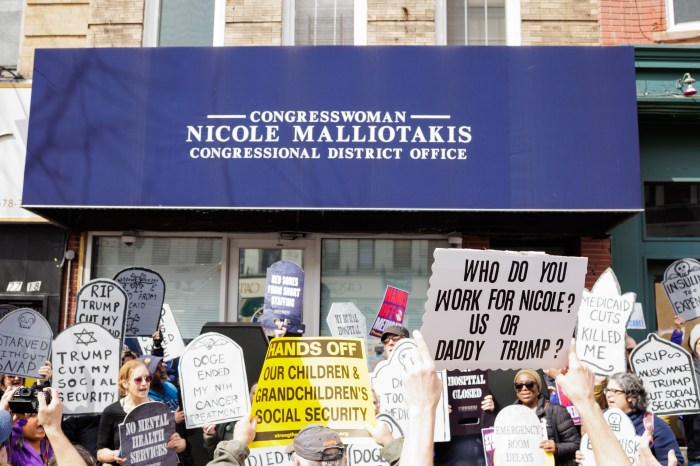
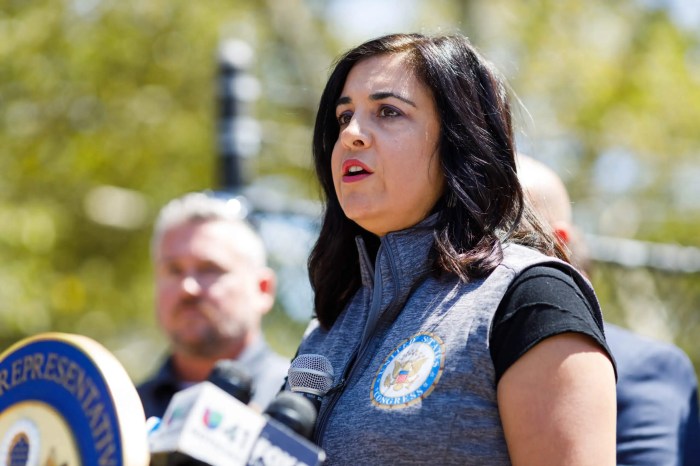
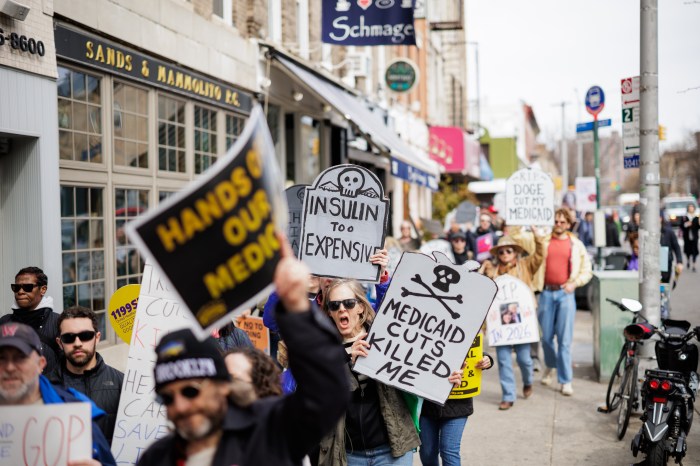
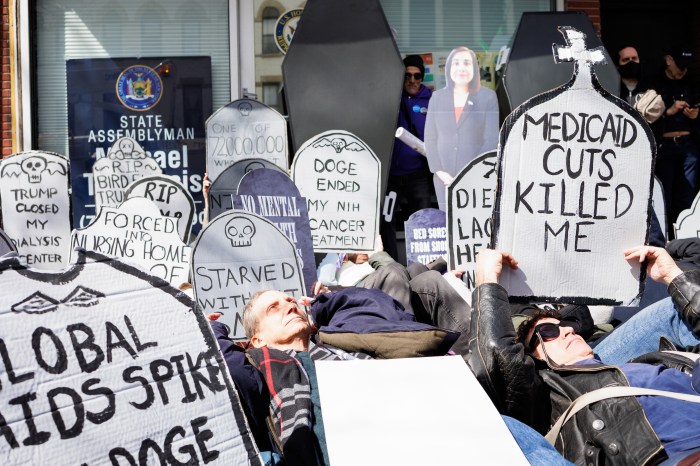
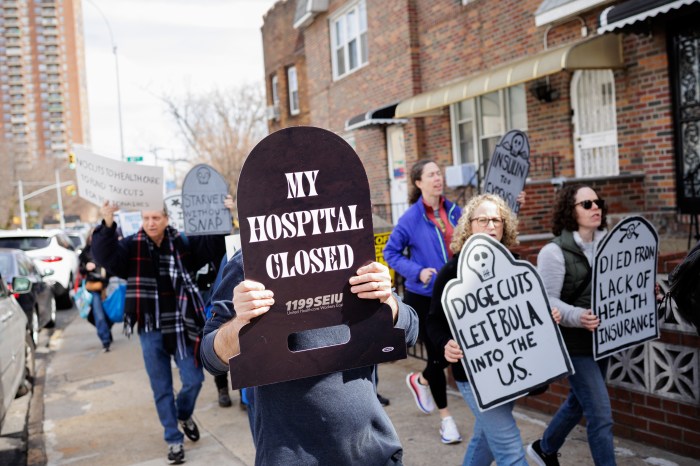


 An NYPD officer keeps watch near a subway entrance at the Fulton Transit Center, Dec. 12, 2024. Credit: Ben Fractenberg/THE CITY
An NYPD officer keeps watch near a subway entrance at the Fulton Transit Center, Dec. 12, 2024. Credit: Ben Fractenberg/THE CITY Federal Department of Transportation Secretary Sean Duffy speaks about sinkholes on I-80 in New Jersey, March 22, 2025. Credit: Screengrab via Secretary Sean Du
Federal Department of Transportation Secretary Sean Duffy speaks about sinkholes on I-80 in New Jersey, March 22, 2025. Credit: Screengrab via Secretary Sean Du